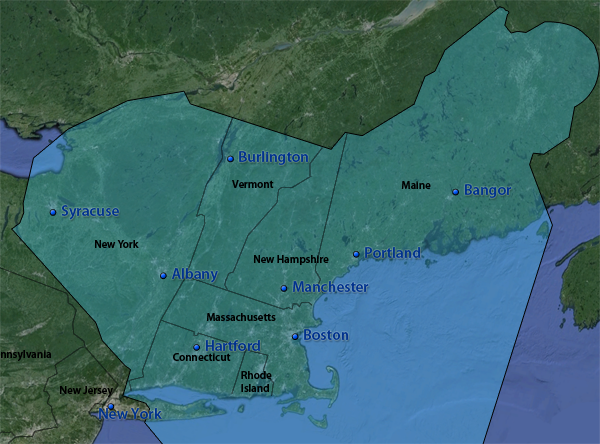
BVA's Getting Started Guide: Start Flying! >> Which Controller do I Contact?
Start Flying Navigation>> Get Ready | Before Start Checklist | Setting up your Aircraft | Connecting to the Network | Filing a Flight Plan | Who do I Talk To?
Controllers at Boston Virtual ARTCC provide ATC within the Boston ARTCC (ZBW). The airspace covers 165,000 square miles of airspace in Connecticut, Vermont, Massachusetts, Rhode Island, Maine, New Hampshire, and parts of New York State:

Active controllers will appear in your pilot client and also on network monitoring tools like Vattastic and VATSpy.
The position the controller is working is identified by the following abbreviations:
Certified controllers always log in to the highest position they wish to control and cover all positions "underneath" that aren’t already staffed. For example, if you see a Boston Approach controller online (e.g., BOS_APP on 133.00), the controller handles approach, and will also cover Boston Tower, Ground, and Clearance, if another controller is not logged on to any of those positions.
If you are ever unsure of which controller to contact, call the controller you think will provide coverage via voice, provide your location, and ask for the correct frequency. The controller will be happy to point you to the right place. Because ATC audio is range-based, if you don't get a response from one controller, you may have to try contacting someone else.
At all times, when there are no controllers online, monitor UNICOM on 122.80, and treat the network as you would for a VFR flight in uncontrolled airspace, making appropriate position reports via text or voice and keeping an eye out for other traffic.
If a controller is logged in as Tower or Ground with no Approach or Center frequency active, that controller will not handle the duties of Approach (i.e., that controller will not provide radar vectors to IFR airrcraft). In this scenario, inbound IFR aircraft should monitor UNICOM on 122.80 until they turn final, and then contact Tower for a landing clearance. Likewise, the departure frequency for all departing aircraft in this situation is also UNICOM. If you’re not flying in an active controller’s airspace, monitor UNICOM to communicate with other pilots and announce intentions.
Radar controllers (working Approach, Departure, or Center) will control "top down" at any towered (Class B, C, or D) airport within their underlying airspace. That means BOS_APP would provide tower services (clearance, taxi, takeoff, etc.) at KBVY, KLWM, KOWD, and KBED, all of which are located within the lateral boundaries of BOS_APP. Thus, a departure from KLWM would also contact BOS_APP for clearance, taxi, and takeoff when LWM_TWR is offline, just as a departure from KBOS would contact BOS_APP for clearance, taxi, and takeoff when BOS_TWR is offline.
One way to determine which "Approach" or "Center" airspace the airport is located in is to look at the airport's communication information by searching for the airport code on AirNav:

In the above image, the airport is located within Boston Center and is also covered by Boston Approach. Assuming there is no Tower or Ground online at the airport, the pilot would contact BOS_APP (if online) or BOS_CTR. If neither of those positions are staffed, UNICOM would be used.
To further clarify which controller is the right one to speak with, consider the following list of active controllers:
In this example scenario:
Please remember that when you leave our ZBW home airspace, you are no longer flying with BVA controllers. While members are encouraged to explore the world of VATSIM, it's important to remember that you are only talking to BVA controllers when you are flying within the Boston (ZBW) ARTCC.
| It's time to begin your flight! |
| Continue to the next section of this guide for tips and ways to get more help |